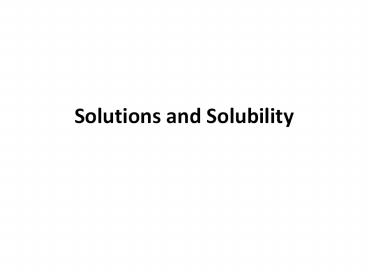Solutions and Solubility - PowerPoint PPT Presentation
1 / 31
Title:
Solutions and Solubility
Description:
Solutions and Solubility * Solubility What does it mean to dissolve? Compounds Compounds are two or more elements chemically joined (held together by chemical bonds ... – PowerPoint PPT presentation
Number of Views:312
Avg rating:3.0/5.0
Title: Solutions and Solubility
1
Solutions and Solubility
2
Solubility
- What does it mean to dissolve?
3
Compounds
- Compounds are two or more elements chemically
joined (held together by chemical bonds) - There is a fixed ratio of components
- Properties of compound are different from those
of the components - Compounds can be separated only by chemical means
4
Mixtures
- Mixtures are two or more substances (elements or
compounds or both) that do not combine chemically
during the mixing. - There is a variable proportion of components
- Properties of each component remain the same as
before mixing - Parts can be separated by physical means
5
More Mixture types
- Alloy mixture of 2 or more metals melted
together having new and different properties,
examples bronze, brass, pewter - Steel is an alloy of iron and carbon.
- Amalgam mixture containing mercury
6
- Solvent the substance that is doing the
dissolving. It is present in the greatest amount.
- Solute the substance that is being dissolved
- Solution the solute and the solvent together.
It is a homogeneous mixture of two or more
substances. - Which of these is
- the solvent?
7
Solubility
- When the solute particles are evenly distributed
throughout the solvent, we say that the solute
has dissolved.
8
(No Transcript)
9
Solubility
- Chalk and talc do not have solubility values.
- These substances are insoluble in water because
they do not dissolve in water.
10
Solubility
- A solution is saturated if it contains as much
solute as the solvent can dissolve. - Any solute added in excess of the substances
solubility will not dissolve.
11
- A supersaturated solution means there is more
dissolved solute than the maximum solubility.
12
- Concentration - a measure of the exact amount of
solute dissolved in a given amount of solvent. - Concentration units - similar to density units
- g of solute
- 100 mL of solvent
- or simply g/100mL
13
Concentrations may be expressed as
- unsaturated able to hold more solute
- saturated holding exactly the max solute
possible
14
- To calculate concentration EXACTLY use this
formula - C mass of solute
- volume of solvent x 100
15
Solubility
- Solubility is a measure of how much substance
(solute) will dissolve at a certain temperature,
in a certain amount of water or other liquid
(solvent)
16
For Example
- 12g of sugar will dissolve in 100mL of water at
room temperature. If you heat the water up to
80C, then 30g of sugar will dissolve. If you
increase the volume of water to 200mL, then twice
as much sugar will dissolve as before. - When expressing the solubility of something you
must give the amount of water used as well as the
temperature.
17
Solubility is a Characteristic Property
- Solubility changes with temperature so the best
way to show the solubility of a substance is on a
graph
18
(No Transcript)
19
Solubility Rules
- Solid solutes
- Dissolve faster AND more in hotter solvents
- Dissolve faster if stirred or crushed up
20
Solubility Rules
- Like Dissolves Like
- Polar molecules dissolve polar molecules (a
polar molecule has a negative pole on one side
and a positive one on the other). The charged
particles attract one another and molecular
motion spreads the solute evenly through the
solvent
21
Solubility Rules
- Non polar molecules dissolve non-polar molecules
without charges being involved. A different kind
of attractive force works on non-polar molecules.
22
Solubility Rules
- Gaseous solutes
- Dissolve faster AND more in colder solvents
- Come out of solution when stirred or shaken
- Like Dissolves Like
23
Solubility of Gases in Liquids
- When you drink carbonated soda, the fizz comes
from dissolved carbon dioxide gas (CO2). - The solubility of gases in liquids increases with
pressure.
24
Liquid Solutes
- Oil and vinegar salad dressing separates because
oil is not soluble in water. - Liquids that are not soluble in water may be
soluble in other solvents.
25
Water as a solvent
- Water is often called the universal solvent.
- Water is a good solvent because of the way the
H2O molecule is shaped.
26
Water as a solvent
- A water molecule has a negative end (pole) and a
positive end. - A molecule (like water) with a charge separation
is called a polar molecule.
27
(No Transcript)
28
Water as a solvent
- Water dissolves sodium chloride (salt) to form a
solution of sodium () and chlorine (-) ions.
29
Water as a solvent
- In general, like dissolves like
- water dissolves polar substances
- non-polar solvents dissolve non-polar substances
30
Solutions
- solution - a liquid homogeneous mixture
containing a dissolved substance - solvent - substance that dissolves the solute.
The component in largest concentration. - solute - substance being dissolved. The component
in smallest concentration - aqueous - solvent is water
- tincture - solvent is alcohol
31
More on Solutions
- Dilute solutions small amount of solute compared
to amount of solvent - Concentrated solution contains more solute than
a dilute solution - Saturated solution when solvent cannot hold any
more solute at a given temperature































